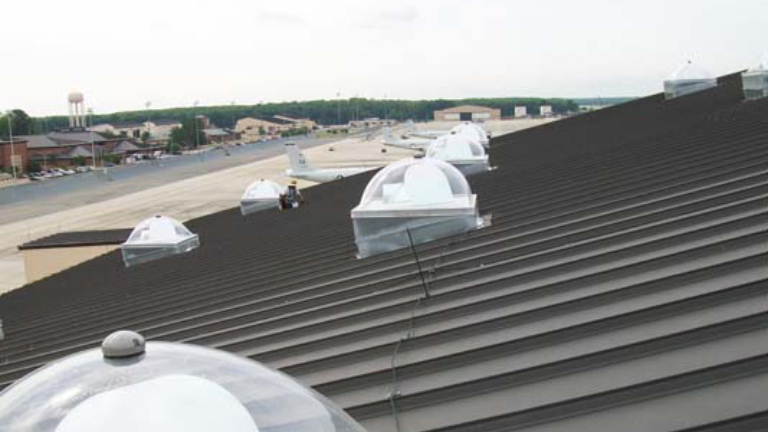Customer Story
Robins Air Force Base
Robins Air Force Base is the home of Warner Robins Air Logistics Complex, the 78th Air Base Wing, and more than sixty other units that make up a vital part of the Air Force war-fighting team. It is the largest industrial complex in Georgia, employing a workforce of more than 24,000 civilians, contractors and military members.

Quick Facts
- Industry
- Local Government
- Topics
- Lighting • Geothermal Systems • Efficiency

Summary
Robins Air Force Base is the home of Warner Robins Air Logistics Complex, the 78th Air Base Wing, and more than sixty other units that make up a vital part of the Air Force war-fighting team. It is the largest industrial complex in Georgia, employing a workforce of more than 24,000 civilians, contractors and military members.
Challenge
The 78th Civil Engineering Squadron, Robins Air Force Base, sought to improve lighting levels in the hangars and engine shop of the 116th Air Control Wing (ACW) of the Georgia Air National Guard. A total of four buildings, with about 500 thousand sq ft, were included in the work scope. Energy savings was very much a focus as the base worked to satisfy requirements outlined by the Air Force Strategic Facility Energy Plan to reduce energy purchased by the Air Force.
Solution
Referring to energy modeling data from audits previously conducted, Robins AFB engineers identified areas where it would be easiest to save energy. As the Air Force drew up its specifications for the lighting upgrade, to increase efficiencies the improvements were bundled with a geothermal project also being planned for the base. The combined lighting/geothermal project was advertised for Robins AFB by the General Services Administration (GSA), competitively bid under the Federal Supply Schedules by three qualified firms and awarded to Trane.
Trane’s proposal outlined a holistic approach, which included day-lighting, dimmable fluorescent lamps and a geothermal water source heat pump system, utilizing the adjacent lake as the heat sink. The plan showed how the combined elements could enhance energy savings for the base.
Optimal illumination with renewable energy
Day-lighting, or Daylight Harvesting, is defined as a renewable project by the Department of Energy. The day-lighting is designed to provide up to 40 foot candles of illumination, reducing the number of lighting fixtures required for optimal illumination and lowering electricity consumption. Natural sunlight from over 300 active tracking skylights provides the majority of the interior lighting requirements during the day. Active tracking skylights differ from passive skylights through the utilization of a solar-powered sunlight tracking device in each skylight dome. This tracking device consists of a mirror array which redirects three times more sunlight into the workspace below, thereby reducing lighting power requirements.
Energy saving lighting upgrades
Inside the facility, light sensors control fluorescent lighting levels based on skylight illumination. Lighting upgrades were installed in buildings, hangars, the maintenance facility and the warehouse operated by Air Guard, Air Force Reserve, 116th ACW and Defense Logistics Agency (DLA) agencies. Over 800 Super T8 high bay fixtures replaced metal halide lamps to bring lighting levels up to required illumination standards and allow the facilities to operate 24x7. Delamping and relocation of lighting and BACnet®-enabled lighting panels were installed to further improve energy savings and operator safety, and meet change of mission requirements.
Quiet, efficient geothermal system
The Robins Billeting Area, consisting of four separate motel and temporary housing buildings for base officers and VIPs, utilized aging, noisy air-cooled chillers for cooling and natural gas boilers for hot water heating and showers. Trane redesigned the mechanical rooms in each building, installing efficient water source heat pumps, controls, high efficiency boilers, hot water storage and pumps. The completed hybrid geothermal system utilizes a local lake as its renewable energy heat source in winter and heat sink in summer. The system consists of 160-tons of geothermal heat pumps paired with specially-designed stainless steel heat exchangers, which were placed in the lake. A desuperheater was added to the system to utilize rejected condenser heat to preheat the domestic hot water, resulting in an 80 to 90 percent energy savings for water heating. The system quietly and efficiently maintains comfortable indoor temperatures in the billeting facilities, while helping Robins AFB to reduce energy consumption and lower greenhouse gas emissions. A water spray fountain was installed in the lake to cool it if necessary.
Additional value potential of new technologies
Trane is also evaluating several new technologies that could potentially provide additional value for the installation. A self-cleaning (air and surface) coating is being tested to determine its ability to prolong light fixture emission due to the inhibition of organic films that attach to the lamp and reflector. A hybrid PV panel that generates power and hot water is also being monitored for panel efficiency and total Btu generation in order to create a more cost-effective renewable solar energy product.
Results
Taking a holistic approach, Trane worked with Robins AFB to implement day-lighting, lighting upgrades and geothermal projects. The improvements have enhanced lighting levels, provide a substantial energy savings, maintain indoor comfort and satisfy requirements of the AF Strategic Facility Energy Plan. Building Lifecycle Cost Analysis (BLCC) shows an ROI of less than ten years and a Savings to Investment Ratio (SIR) of over 2.0. Useful life of the geothermal and day-lighting systems is expected to be more than twenty years.
About Robins Air Force Base
Over 300 skylights installed at Robins AFB use solar-powered sunlight tracking to redirect three times more sunlight into the workspace below.
A hybrid geothermal system utilizes a local lake as its renewable energy source and heat sink.
